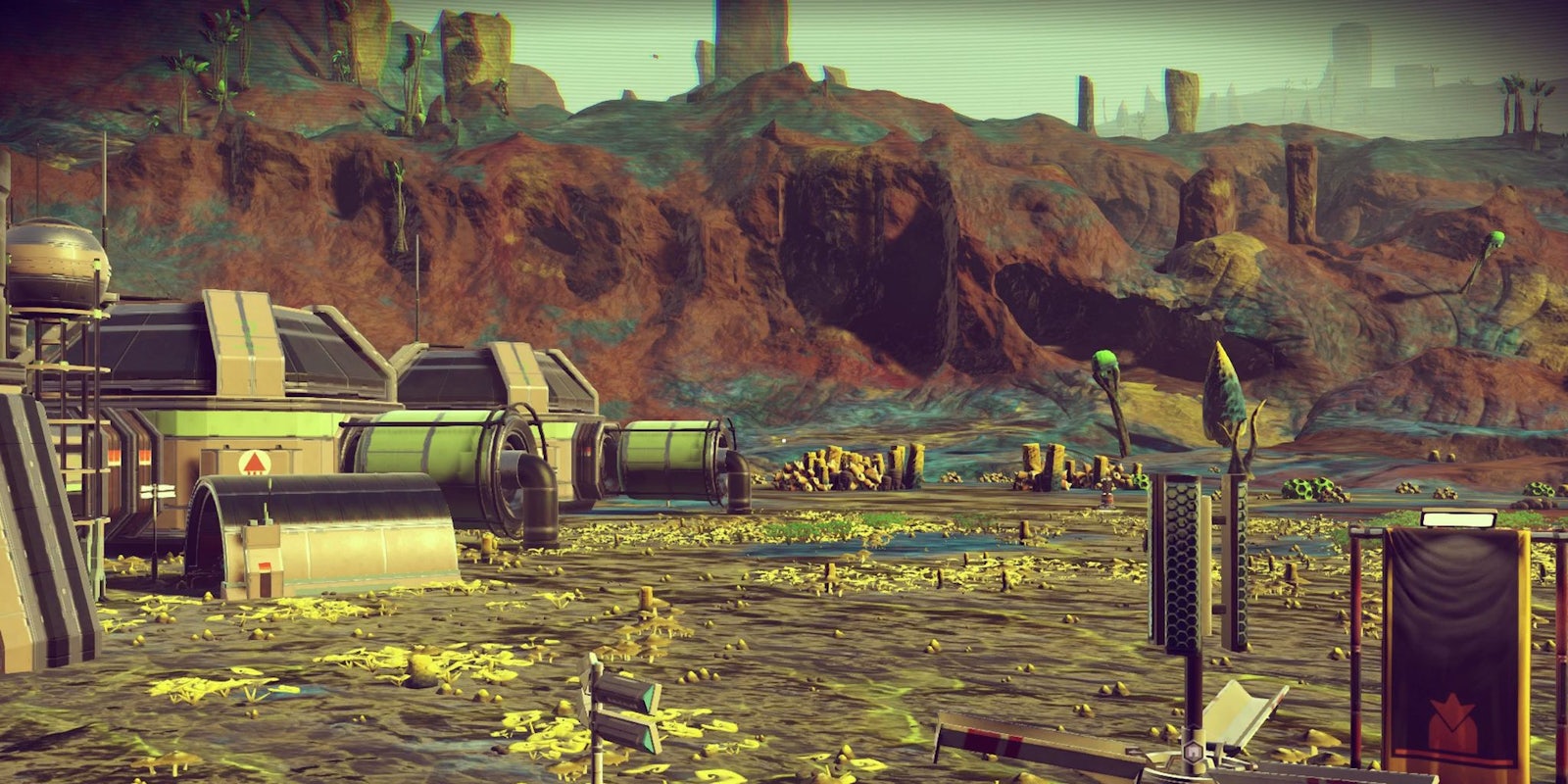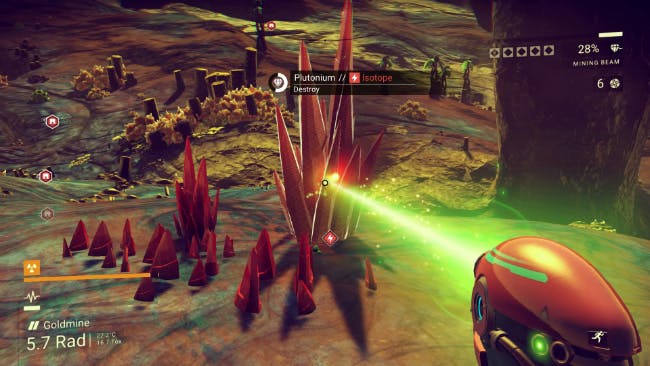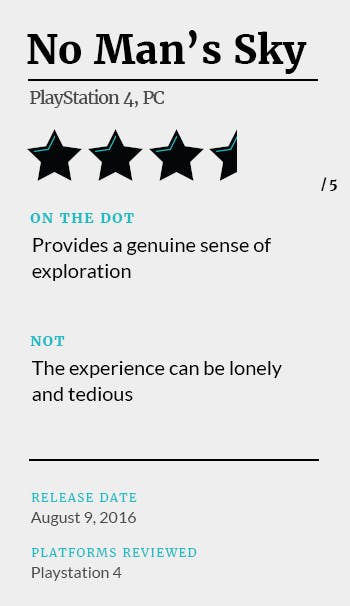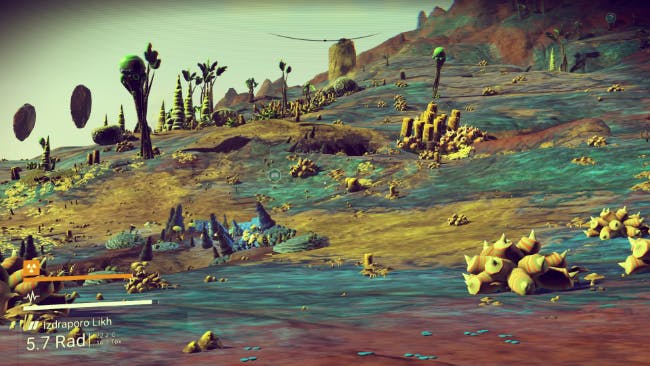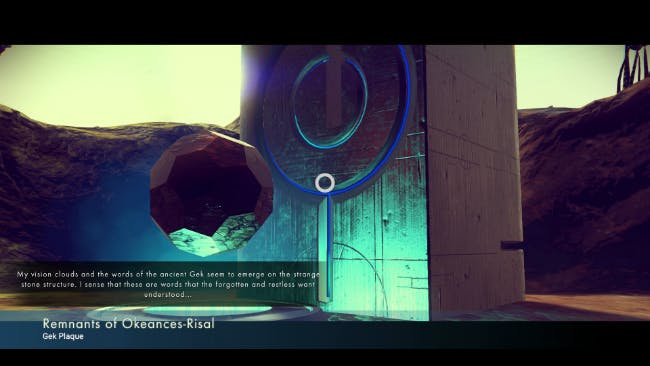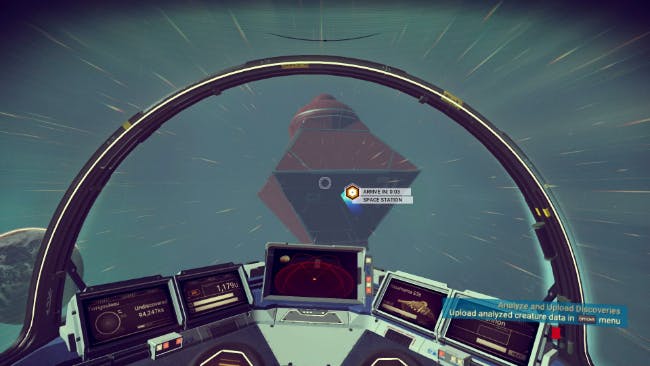Imagine all the natural laws of our universe, all the laws of physics and chemistry and biology that dictate how things behave in our reality, expressed in a single mathematical equation. Now imagine the Big Bang, the massive explosion of matter and energy that we currently theorize as the beginning of our universe. Everything that took place after the Big Bang was subject to the rules contained within that mathematical equation.
Hello Games, the developer of No Man’s Sky, essentially programmed a fictional version of that mathematical equation, and then flipped a switch that created the over 18 quintillion planets of the Euclid Galaxy in which No Man’s Sky takes place.
This technique for creating content in a video game is called “procedural generation,” and game developers have been using the technique for almost four decades. Procedural generation is how Minecraft creates new worlds for players to explore, and how Spelunky creates its devilishly difficult platforming levels. What makes No Man’s Sky different is the sheer scale at which the game employs procedural generation.
One has to appreciate the audacity of this. But respect for the programmatic underpinnings of the Euclid Galaxy is an intellectual exercise separate from the moment-to-moment experience of exploring the Euclid Galaxy. That’s important because No Man’s Sky is simultaneously engaging and boring in equal measure.
Playing No Man’s Sky feels similar to living life in the real world. You put up with tremendous amounts of tedium and drudgery: going to work five days a week to make money to pay the bills, running errands, and cleaning the house, and all the other things we do not because we enjoy them but because we have to. And then, we have the opportunity to explore the natural beauty of our planet, to forge meaningful relationships with one another, and to experience joy.
Read More:
- A complete beginner’s guide to No Man’s Sky
- This is how No Man’s Sky creates over 18 quintillion planets
Much of No Man’s Sky is boring as hell. You land on a planet or moon, gather raw elements like zinc and copper and plutonium, and fill the hold of your starship with them. You use those elements to craft fuel for your starship, and for the exosuit that protects you from the hazards of the planets you visit, and for the multi-tool that allows you to mine rocks and defend yourself with powerful laser beams.
No Man’s Sky is simultaneously engaging and boring in equal measure.
You sell the elements for units, the form of currency in No Man’s Sky, and then use those units to purchase elements that you need but cannot find on planets to gather or mine for yourself. You also use those units to purchase larger and better starships with more space for the elements you’re gathering and for the technologies that make the starship more powerful. And all of this is tantamount to manual labor and accountancy.
I found a planet that was rich in gold. I spent four hours mining gold, stuffing it into the cargo hold of my starship, taking the gold to a nearby galactic trade terminal to sell the gold for millions of units, and then heading back out to mine more gold. I did this to earn the millions of units I would need to purchase the starship in which I am currently exploring the Euclid Galaxy. But I also did this simply because I could. After spending many preceding hours only finding gold in small crystalline deposits in caves, to then find a world whose surface was literally shining with giant towers and hills of the stuff was too good an opportunity to ignore.
Discovering the planet was a moment of wonder. Taking advantage of what I’d found was mind-numbingly dull, yet I was perfectly happy doing it.
Playing No Man’s Sky is very similar to my experience of playing Minecraft. I will spend months exploring a Minecraft world, gathering coal and iron and diamonds to make the weapons and armor, brewing the potions and enchanting the gear I need to keep me alive. I go on mapping expeditions to chart the entire world. And then I invariably spin up an entirely new Minecraft world so I can start over again from scratch and enjoy the thrill of discovery.
That’s similar to how it feels every time I set foot on a new planet in No Man’s Sky. I know the sort of things I will discover there, like animals and plants and rocks to be scanned and cataloged. I know I will find drop pods that contain technology I can use to expand my exosuit’s inventory, and transmission towers that elucidate points of interest to investigate, and broken technology I can salvage to discover crafting recipes, and trading posts and outposts that might either be derelict or contain aliens for me to converse and do business with.
But I don’t know precisely where or how many of these things there are. Exploring is a slow and often boring process: Fly starship to waypoint. Jump out of starship. Run over to thing to examine it. Jump back into starship. Fly starship to next waypoint. I have no idea whether any of this time and effort will be rewarded with anything valuable.
When I find a new and better multi-tool, or a crashed starship that is larger and better than the starship I am currently flying and that I can repair and then take as my own, or when I discover an alien species whose size shocks me, or when I discover a planet covered in gold, the thrill of discovery balances the scales and I forget about the tedium I put up with in order to make the discovery.
To a point, No Man’s Sky feels too big to judge. The more I explore the Euclid Galaxy, however, the more the illusion of being in a galaxy of infinite variety begins to break down. I have discovered three different forms of the same, small insect on three worlds that are thousands of light-years apart from one another. I realized that the alien species are more or less constructed of extraterrestrial Lego, the same parts mixed-and-matched over and over again in admittedly a huge number of potential combinations but not enough to hide the underlying system behind their construction. The more starships I see, the more I recognize that they are also essentially composed of mixed-and-matched Lego pieces. The same goes for various in-game minerals.
In Minecraft, I can invite other people to share my discoveries. In No Man’s Sky, I am utterly alone.
The experience of exploring planets in No Man’s Sky is similar in this respect to the experience of exploring planets in the original Mass Effect. What you find inside a building may be different, but the buildings themselves are virtually identical architecturally, or at best constructed in very limited variety. The aliens you encounter may say different things, but all your conversations are variations on the same themes.
Everywhere I turn in No Man’s Sky I find tedium and satisfaction in equal measure. I have only found the ultra-rare element called Radnox on a single planet that was intensely hot and wracked with storms that could strip the hazard protection off my exosuit in less than a minute. The Radnox was distributed in small piles of rocks that when mined barely gave up any of the stuff. I knew it was going to take me a long time to gather a healthy stockpile of the element, darting back and forth from the protection of my starship, braving the violence of the storms to pick up a few pieces of Radnox here and there.
I think it took me an hour to gather one full inventory slot of Radnox. It was a boring and frustrating experience. I couldn’t even tell you why I need Radnox. I won’t sell it because it’s rare. I don’t have any crafting recipes that require it. But like some kind of galactic hoarder, I am pleased to have a small pile of the stuff just in case I do need it some day.
The one frustration in No Man’s Sky I am not willing to put up with is its atrocious starship combat. I didn’t expect Hello Games to create a Wing Commander or X-Wing inside the confines of the larger game, but there are basic elements to a competent space combat game that are missing in No Man’s Sky, like the ability to lock targets.
You also need to pop into your inventory to recharge your shields, which means, in essence, putting the ship on autopilot for five seconds or more, which is a terrible idea while half a dozen enemy starships are pounding away at you. I don’t answer distress calls. I run from warning signals of approaching hostile ships. I sincerely hope that No Man’s Sky never forces me to engage in starship combat for any reason because it would be a miserable experience.
The comparison between Minecraft and No Man’s Sky breaks down on three points: endgame content, community, and creativity.
In Minecraft, you can choose to kill the Ender Dragon. It lives in an alternate dimension called The End. Finding and activating a portal to The End takes a considerable amount of time and exploration. Preparing the weapons, armor, and consumables you need to successfully kill the Ender Dragon also takes time.
The one frustration in No Man’s Sky I am not willing to put up with is its atrocious starship combat.
This is not an official quest line. There are no quest steps that track your progress toward the goal. The game does not end when you kill the Ender Dragon. It is a challenging task you can set for yourself, by way of proving your mastery of the game world and its systems.
There are two pseudo-quests in No Man’s Sky that I’ve discovered. The first is to journey to the center of the galaxy. The second is to follow a trail of giant, alien monoliths in space called Atlas Interfaces. I have undertaken the Atlas path, and at this point, it involves nothing more than jumping through hyperspace from system to system.
I’ve stored all the elements I need to craft ad nauseam the warp cells that power my starship’s hyperdrive. I suspect that I’ll never have to set foot on the surface of another planet if I don’t want to and will still be able to achieve my goal of finding the end of the Atlas path.
I do not expect challenging combat at the end of this journey, as I would experience if I undertook to kill the Ender Dragon in Minecraft. I don’t know what else to do, however, now that I’ve seen all the Lego-like systems that define the planets and animals and starships of No Man’s Sky, and the illusion of infinite variety promised by a procedurally generated galaxy has broken down.
The Euclid Galaxy is so large that the chances of your running into another player are close to nil. All the star systems, planets, moons, rocks, animals, and plants you discover should therefore always be fresh discoveries, and you can upload those discoveries to a galactic database to earn units.
You have the option to rename these discoveries when you upload them to the database. At first I renamed planets in a utilitarian fashion, using names like “Gold Mine” or “Copper Here!” in case I ever needed more of those elements and wanted to return to the worlds. But the further along I get along the Atlas path, the more I accept that I will never, ever, return to any planet I have visited.
I don’t bother naming anything anymore, not when I also know that no one will ever be able to stumble upon and appreciate the names that I’ve given things. Unless I’m willing to spend the time uploading screenshots and videos to YouTube or social media, which I am not, no one will ever see what I’ve done. And that can make the process of discovery feel meaningless.
Would Christopher Columbus’s journey have mattered if no one had heard what he’d found? In Minecraft, I can invite other people to share my discoveries. In No Man’s Sky, I am utterly alone.
In Minecraft, I can build things with all the elements I mine and gather, castles and railroads and giant machines, and leave my imprint on the world. I can’t build anything with the elements I gather in No Man’s Sky other than items and technology that make it less likely to be killed while gathering yet more elements.
Now that I think I have what I need to reach the end of the Atlas path, I have no motivation to explore planets other than for its own sake, which becomes less interesting the more I play. Exploring planets is beginning to feel not entirely meaningless, but certainly without purpose.
I have only met two recurring characters in No Man’s Sky. Nada is a member of a race of sentient AI called the Korvax. His assistant Polo is a member of a reptilian race called the Gek. I will find them conducting research within giant spherical space anomalies that appear in different star systems.
They barely deserve to be called characters for the lack of dialogue or meaningful interaction. Nada points out the locations of Atlas Interfaces to which I can travel, and Polo gives or sells me technology. That’s it. Yet I’m still always happy to see them because they are the only familiar faces I have to cling to.
Nada and Polo represent what’s missing from the game. Plot. Characters. Structure. Even with over 18 quintillion planets, the Euclid Galaxy feels empty and sad. I want a reason to exist there other than to travel to a specific point on the map. No Man’s Sky needs its Ender Dragon.
Score: 3.5/5
Disclosure: Our PlayStation 4 review copy of No Man’s Sky was provided via Sony Interactive Entertainment.

